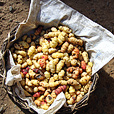|
|
In This Section:See Also:
|
BiodiversityAndean Agroecologies: Roots and Tubers
Most Andean roots and tubers yield well with low inputs. They also successfully withstand most biotic and abiotic stresses. In addition to their ability to grow at high altitudes under extremely difficult conditions, these crops have a wide range and mix of desirable characteristics: high vitamin, micronutrient, and starch content; high yields; and medicinal properties.






Source: CIP (www.cipotato.org) Andean tubers (ulluco, oca, mashua) and roots (arracacha, yacón, mauka, achira, ahipa, maca) provide food and income for poor mountain farmers across the Andean highlands. These crops have extraordinary pest and disease tolerance and nutrient efficiency, and they adapt to marginal environments. They yield well on poor soils and under adverse climatic conditions. As a result, an extremely complex mosaic of Andean agroecologies has evolved for these crops. Over time, farmers have selected them to fit a range of elevations, with diverse farming conditions, by using different agronomic practices. Some of the nine crops have been favored more than others, so the intensity of domestication and the range of biodiversity in these roots and tubers vary from crop to crop. These crops are largely unknown outside of the Andean region. |